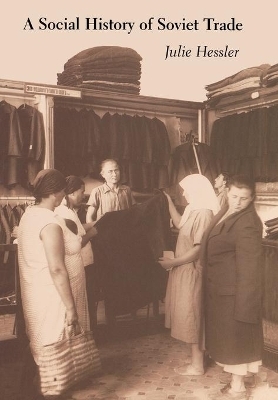
A Social History of Soviet Trade
Princeton University Press (Verlag)
978-0-691-11492-7 (ISBN)
In this sweeping study, Julie Hessler traces the invention and evolution of socialist trade, the progressive constriction of private trade, and the development of consumer habits from the 1917 revolution to Stalin's death in 1953. The book places trade and consumption in the context of debilitating economic crises. Although Soviet leaders, and above all, Stalin, identified socialism with the modernization of retailing and the elimination of most private transactions, these goals conflicted with the economic dynamics that produced shortages and with the government's bureaucratic, repressive, and socially discriminatory political culture. A Social History of Soviet Trade explores the relationship of trade--official and unofficial--to the cyclical pattern of crisis and normalization that resulted from these tensions. It also provides a singularly detailed look at private shops during the years of the New Economic Policy, and at the remnants of private trade, mostly concentrated at the outdoor bazaars, in subsequent years.
Drawing on newly opened archives in Moscow and several provinces, this richly documented work offers a new perspective on the social, economic, and political history of the formative decades of the USSR.
Julie Hessler is Associate Professor of History at the University of Oregon.
List of Illustrations ix List of Tables xi Preface xiii Introduction 1 Two Modes of Soviet Socialism 4 Buyers, Sellers, and the Social History of Trade Crisis: Revolution 9 Chapter One Trade and Consumption in Revolutionary Russia 19 Russian Retailing and Its Unraveling 20 Effects of the Anti-trade Policy 27 The Crisis Mode of Consumption 38 Conclusion 48 Chapter Two The Invention of Socialism 51 The Emergence of a Socialist Distribution Network, 1918-1921 53 Rationing, "Commodity Exchange," and Price Controls 61 The Antibureaucratic Backlash and Socialist Economic Culture 79 Public-Sector Shops in the Transition to the NEP 87 Conclusion 97 Chapter Three Shopkeepers and the State 101 Poverty, Capital, and the Commercial Revival 103 The Logic of Utilization and the Regulatory Context 113 Shopkeepers 'Stories: The NEP from Below 119 Conclusion 130 Crisis: Restructuring Chapter Four War Communism Redux 135 The NEP from Above: Trade Policy in the Shadow of the Goods Famine 137 Bureaucratism Ascendant: The Effects of Food Shortage on the Distribution System 154 Corporatism in the Service of the Plan 173 Crisis, Consumption, and the Market 184 Conclusion 193 Chapter Five Toward a New Model 197 Socialist Modernization: "Cultured Soviet Trade" 198 Bureaucratism Restrained 215 Stalinism and the Consumer, I: Urban Attitudes and Trends 222 Stalinism and the Consumer, II: The Peasant Challenge to Cultured Trade 230 Conclusion 243 Crisis: War Chapter Six The Persistent Private Sector 251 Stalin-era Bazaars 252 Travel, Bagging, and the Survivalist Consensus 273 The Revitalization of the Private Sector 279 Private Trade as a Social Formation: Continuity and Change 289 Conclusion 293 Chapter Seven Postwar Normalization and Its Limits 296 From Wartime "Abnormalities" to the Paradox of Growth 298 Cadres Policy in Postwar Trade 310 Postwar "Cultured Trade": A Balance Sheet 316 Conclusion 325 Conclusion 329 Bibliography 337 Index 355
| Erscheint lt. Verlag | 22.2.2004 |
|---|---|
| Zusatzinfo | 13 halftones. 10 tables. |
| Verlagsort | New Jersey |
| Sprache | englisch |
| Maße | 152 x 235 mm |
| Gewicht | 680 g |
| Themenwelt | Geschichte ► Teilgebiete der Geschichte ► Kulturgeschichte |
| Geschichte ► Teilgebiete der Geschichte ► Sozialgeschichte | |
| Geschichte ► Teilgebiete der Geschichte ► Wirtschaftsgeschichte | |
| Technik | |
| ISBN-10 | 0-691-11492-7 / 0691114927 |
| ISBN-13 | 978-0-691-11492-7 / 9780691114927 |
| Zustand | Neuware |
| Haben Sie eine Frage zum Produkt? |
aus dem Bereich


